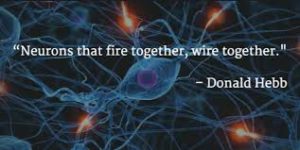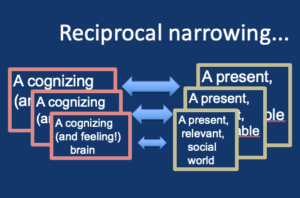My blogging days may be winding down. But if they do, as they do, I want to put more energy into methods for helping beat addiction than ideas for explaining it. It’s critical to understand addiction in depth, and I still believe that linking neuroscience with lived experience provides a potent frame of reference. But lately I’ve been moving on, thinking almost exclusively about treatment. Is there a connection from brain parts to mind parts to effective methods for helping people? Let’s see.
I started this blog with an emphasis on addiction neuroscience. I can sum up most of that brain stuff in a few simple conclusions, but I’m going to add some points of clarification:
-even though brains change with addiction, addiction is not a brain disease, as often claimed. The brain changes with any and all learning, and the more emotional and repetitive the learning events, the greater and more enduring the resulting brain changes.
-habits are inscribed in synaptic networks (networks of connections among neurons). Those networks become the hardware for processing new information: “What fires together wires together.” Thus, novelty gets sidelined by habitual patterns of thought, feeling, and behaviour. That’s the case with love, politics, religion, and yes, addiction.

-the “narrowing” of synaptic networks is mirrored by a narrowing of the social world. Friends, family, finances, legal circumstances all become more limited, more “narrow,” for the person who finds fewer neural avenues for pursuing rewards. You’ve heard that life imitates art? It’s also the case that social change imitates brain change. (See my review article here.)

-the “narrowing” metaphor suggests that the connections between different brain parts become more entrenched, less open to change. But that doesn’t mean that diverse neural regions become fused in some way. The brain retains its functional components (e.g., frontal regions underlying conscious attention versus limbic structures in charge of automatic behaviour) and those components are designed to compete.
So now what? With all we know about the science and psychology of addiction, how do we put it all together? How do we help?
The neuropsychology of addiction is important! It exposes us to many critical concepts, like the biological embedding of habit formation. Yet we don’t generally treat addiction, either in ourselves or others, by altering the brain. At least not directly. We don’t perform lobotomies or lobectomies, nor is it common to use deep-brain stimulation or transcranial magnetic stimulation to help people recover. No, when it’s time to turn from thinking to helping, we turn to talk, often in the form of psychotherapy.
Talk is social behaviour. So the goal is to free up addicted people by expanding their social world, especially the social world they carry around in their minds — the way they talk to themselves, the way they interpret messages from others. At that point the neuropsychology of addiction takes a back seat, as an aid to our clinical intuitions and our capacity to listen. Once again, lived experience, both that of the client and of the therapist, becomes the needed partner for our scientific theories.
Now if both the brain and the social world “shrink” in tandem, then we should be able to “grow” the brain (the realm of synaptic possibilities) by “growing” social-psychological flexibility. How can this be achieved?
(There is one method of acting on the brain directly, bypassing all that messy talk stuff. We can give the addicted person drugs that directly affect their neurophysiology and/or how they think and feel. Antidepressants and antianxiety drugs to target underlying mood states, methadone or naltrexone to nudge drug-soaked synapses out of their ruts. But in my view, psychotherapy — if it works — goes deeper, induces changes that last longer, and provides a sense of well-being that no drug can mimic.)
I find Internal Family Systems (IFS) therapy to be the most effective form of talk therapy available. You’ve heard me rave about it over the last few posts. I’ll end today by pointing out that IFS brings to the table a fundamental experience that most addicts find exhaustingly familiar. For them (and of course I include myself) the internal social world, the voices in our heads, are most conspicuous because they are at war with each other. The internal critic tells you that your wishes and goals are reprehensible. But the childish wishes don’t go away. In fact, they get stronger, fueled by defiance against the internal critic and desperation to meet needs that are hunted down and locked away.

By recognizing this internal duality, this multiplicity of conflicting part-selves, IFS brings empathy and clinical intuition to bear on what neuroscientists already know but never think about. Brains are composed of components that are designed (by evolution) to compete with each other. Frontal inhibition (lateral prefrontal cortex) versus learned habits (striatum), future oriented action tendencies (dorsal cortical circuits) versus preoccupation with threats (ventral cortex and amygdala). These tendencies are supposed to compete. That’s what gives humans their incredible capacity for choice and intelligent action.
How did we psychologists forget that when going about devising treatment strategies?
So, here’s the breath of fresh air provided by IFS. Conventional methods of treating addiction involve training people to “just say No.” That doesn’t work. Mounds of disappointing outcome stats make that clear. Why doesn’t it work? Because it ignores the lived experience of people in addiction and it ignores the way brains actually work. In contrast, IFS trains people to listen to the voices or “parts” that occupy their minds and accept them, welcome them, soothe them, without trying to shut them down. In that sense, it respects the idea that the mind — as well as the brain — is multiple, and it is composed of competing functions.
But that’s enough for today. In my next post I want to be very explicit about the IFS alternative to “Just say No.”

Leave a Reply to Joanna NicciTina Free Cancel reply